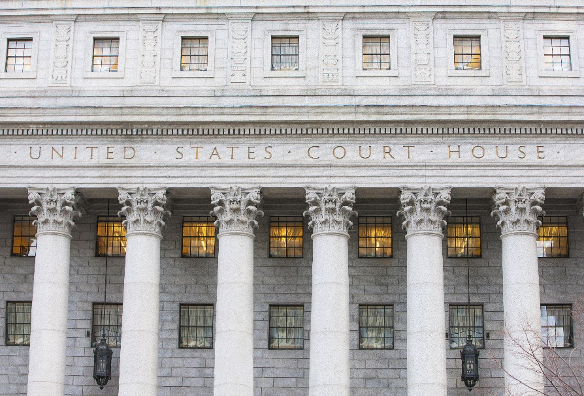Patent Law Alert – U.S. Supreme Court gives USPTO Director the Power to Review and Overturn Patent Validity Decisions by the Patent Trial and Appeal Board

In a long-awaited decision, the U.S. Supreme Court ruled on June 21st that the administrative patent judges (APJs) of the U.S. Patent and Trademark Office’s (USPTO) Patent Trial and Appeal Board (PTAB) were unconstitutionally appointed. To correct this error, the Supreme Court gave the USPTO Director the discretionary power to review and overturn PTAB decisions.
United States v. Arthrex, Inc. et al. (594 U. S. ___ (2021)) creates a significant, additional layer of review within the USPTO, and thus, will impact the associated costs and timeframes for final USPTO patent invalidity decisions.
Background
In 2015, Arthrex secured a patent on a surgical technique for reattaching soft tissue to the bone, and sued Smith & Nephew, Inc. and ArthroCare Corp. for patent infringement. The defendants sought to invalidate the asserted patent via the USPTO’s inter partes review proceeding. At the conclusion of that proceeding, a panel of three APJs found the patent invalid in light of prior art.
Arthrex appealed the PTAB decision to the Court of Appeals for the Federal Circuit (“Federal Circuit”). Arthrex asserted, among other things, that the APJs were unconstitutionally appointed and therefore the PTAB finding of patent invalidity was itself invalid.
Arthrex argued that since APJs are principal officers, that is, officers whose decisions are not reviewable within the executive branch (except by the President), Article II, Section 2 of the Constitution (Appointments Clause) required that they be appointed by the President, with the consent of the Senate. Instead, the APJs had been appointed by the Secretary of Commerce (Secretary) in violation of the Appointments Clause. As a result, Arthrex argued, the APJs lacked constitutional authority to render the final decision within the USPTO that invalidated the patent at issue.
The Federal Circuit agreed with Arthrex and found that the APJs were principal officers; not so-called inferior officers, who operate under the direction and supervision of the Secretary or USPTO Director. The Federal Circuit sought to fix the constitutional defect by severing the statutory provisions that provided tenure protection to APJs. This, in turn, gave the Secretary the power to fire APJs at will, rendering the APJs inferior officers. The Federal Circuit then vacated the Arthrex PTAB decision and remanded it for a rehearing before a new APJ panel.
The U.S. Supreme Court’s Decision
The Supreme Court neither agreed nor disagreed with the Federal Circuit’s finding that APJs are principal officers, but nevertheless held that the APJ appointments were in violation of the Appointments Clause.
The Supreme Court found the Federal Circuit’s “fix” inadequate since removal of APJs by the Director does not address errors in the final decisions previously issued by the removed APJs. Rather, the Supreme Court decided that the appropriate remedy was to empower the USPTO Director to review and overturn, at the Director’s discretion, any PTAB decision.
The Supreme Court explained that 35 U.S.C. §6(c), which designates that at least three APJs conduct inter partes proceedings, “cannot constitutionally be enforced to the extent that its requirements prevent the Director from reviewing final decisions rendered by APJs.” The appropriate tailored solution, according to the Supreme Court, is to give the Director such power.
Thus, the Supreme Court, in Arthrex, has established a new procedure, wherein each inter partes review decision will be sent to the Director, who could then decide whether or not to review and overturn the decision.
Impact and Uncertainties caused by Arthrex
Disappointed parties now have the option of seeking the Director’s review of PTAB decisions before proceeding to the courts for yet further review of those decisions. While this may be a welcome change to some parties, the added optional review contradicts at least one primary goal of the America Invents Act[1], which is to streamline and reduce the cost of patent litigation. Irrespective of whether or not the Director actually reviews a PTAB decision, seeking such review will certainly add extra costs and delay to the entire proceeding.
The form and substance of requests for review by the Director will now need to be established. Will the requests require detailed briefing of the APJs’ alleged errors?
The Director will also need to figure out how to handle the new workload, which is expected to be significant. It’s hardly feasible for the Director, along with a review team that the Director will establish, to review every decision. Will the Director only consider review of decisions upon request? Will the Director give deference to the APJs’ findings or review from scratch? Moreover, the USPTO Director is a political appointee, whose role has now taken on added significance due to this newly established review power.
And, what about other PTAB proceedings? The Arthrex decision addressed inter partes review decisions by APJs. However, APJs conduct other types of appeals, including ex parte reexamination, post-grant review, and applicant appeals from final rejections of pending patent applications. Will disgruntled patent applicants, who lose on appeal at the PTAB, be given the additional opportunity to have the Director review and overturn those PTAB decisions?
We will continue to watch the activities of the USPTO and its Director for further impact on all types of USPTO proceedings.
For further information, contact Mark Montague, Daniel Basov, or your CLL attorney.

Partner
Email | 212.790.9252
Mark is head of the firm’s patent group. Mark is a patent attorney registered to practice before the U.S. Patent and Trademark Office, and has over 25 years of experience counseling large, medium, and small-sized companies in a variety of technical fields. Mark’s practice focuses on advising clients on the protection of inventions in the U.S. and abroad, defending clients against charges of patent infringement, conducting patent due diligence studies (e.g., patent infringement analyses, patent validity analyses), and overseeing other attorneys and personnel in the firm’s patent group.

Senior Attorney
Email | 212.790.9278
Daniel is a patent attorney registered to practice before the United States Patent and Trademark Office, with significant experience in representing technology clients in all aspects of intellectual property-related matters, including litigation, appeals and inter party reexamination proceedings (IPRs), and prosecuting patent applications in a variety of technologies, including computer software, blockchains and digital currency, analytics and big data systems, artificial intelligence, wireless communications and computer hardware, electronics, medical, surgical and optical devices, business methods, mechanical and electro-mechanical devices and other technologies.
[1] The Leahy–Smith America Invents Act, more commonly known as the America Invents Act (AIA), enacted on September 16, 2011, made numerous changes to U.S. patent law, including changes to the USPTO post-grant opposition proceedings, and specifically established the substantive and procedural rules of inter partes review.